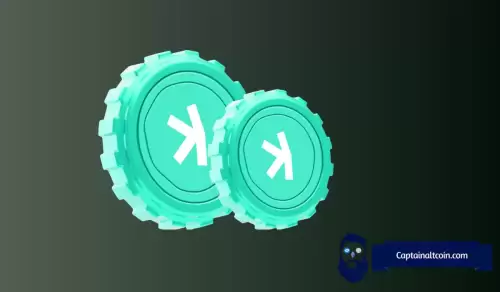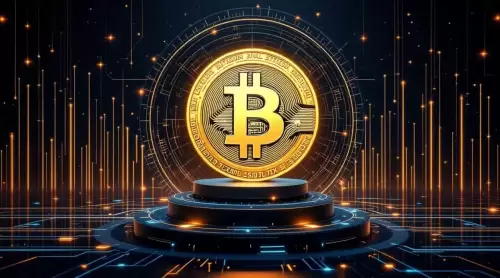 |
|
 |
|
 |
|
 |
|
 |
|
 |
|
 |
|
 |
|
 |
|
 |
|
 |
|
 |
|
 |
|
 |
|
 |
|
Cryptocurrency News Articles
Speech by Piero Cipollone, Member of the Executive Board of the ECB, at the France Payments Forum event “Digital euro and the future of payments in Europe”
May 15, 2025 at 03:16 pm
This speech by Piero Cipollone, Member of the Executive Board of the ECB, at the France Payments Forum event “Digital euro and the future of payments in Europe”

The France Payments Forum event “Digital euro and the future of payments in Europe”
Paris, 15 May 2025
Good morning everyone.
It is a pleasure to be joining you today at France Payments Forum's event on the digital euro and the future of payments in Europe.
Most people associate the adoption of the euro with the launch of euro banknotes and coins. While the euro was introduced for accounting purposes in 1999, we tend to feel it only became our money three years later once we started paying in euro cash around Europe. Euro banknotes and coins made the currency the tangible symbol of a united Europe.
A strong currency also comes in tandem with strong payment systems. We at the central bank offer payment infrastructures that form the plumbing of the financial system. Less visible than banknotes and coins, these infrastructures are nevertheless key to our monetary and financial integration.
Retail and wholesale payments are hence an integral part of our tasks at the central bank. We issue cash, supply reserves – the ultimate liquid asset – to banks and operate payment systems, thereby supporting our economy by enabling euro area transactions that are secure, risk-free and European. This is what preserves our economic stability and our monetary sovereignty.
Building on this reliable base, private sector firms can then offer their own solutions, without their customers having to worry about the money they use. One euro is one euro, because private money can be converted to cash at all times and because financial transactions can be settled in central bank money – the only risk-free asset there is.
So today, I want to focus on how we can make our currency future-proof and enhance the integration, competitiveness and resilience of European payments in the digital era.
As people increasingly prefer to pay digitally and online commerce expands, the role of cash as a universal payment solution is declining. We thus risk being left without a European solution that allows us to pay throughout the euro area in all situations. To restore the central role of cash, we need to complement physical cash with its digital equivalent, a digital euro. Making central bank money available in digital form might seem like a small and obvious step, but it is in fact an essential one for overcoming the entrenched and longstanding fragmentation of our payment market. The digital euro will achieve this directly by modernising the supply of public money and indirectly through its infrastructure and acceptance network, which private payment service providers can leverage to expand and innovate on a European scale. Ultimately, a digital euro will enhance the competitiveness of European providers and their ability to offer all types of digital payments to European consumers.
The situation is different for wholesale financial transactions as we already offer settlement in digital central bank money and do not face the same dependencies. However, market participants increasingly expect that tokenisation and distributed ledger technology (DLT) will transform financial transactions by enabling assets to be issued or represented as digital tokens. We are currently expanding our initiative to settle DLT-based transactions in central bank money. By making central bank money available, we avoid the risk of other settlement assets being used, such as US dollar stablecoins, which would reintroduce credit risk, fragmentation and a dependency on non-European solutions.
We are progressing on the retail and wholesale fronts in parallel. In both cases, Europe needs its own, sovereign money for the digital era, so that it can harness the benefits of integration, innovation and independence. In the words of the late French economist Michel Aglietta, money is not just a technical device, it is an essential institution.[1]
A digital euro for everyday payments
Let me first discuss the rationale for the digital euro and the benefits it will bring.
Currently, cash is the sole sovereign payment method across the euro area. It offers Europeans a convenient, secure and universally accepted way to pay and store value, ensuring financial inclusion. Cash also upholds the resilience of our payment systems and economies, acting as a reliable fallback during crises such as cyberattacks or power outages. This is why we remain strongly committed to cash.[2]
However, digital payments have gained popularity, with online shopping accounting for more than a third of our retail transactions. This means that acceptance of and access to cash are no longer sufficient to cover a growing share of payment situations. In value terms, cash payments made up only 24% of day-to-day payments in the euro area last year.[3]
Lacking a genuine European payment solution that works across the euro area, we are left critically dependent on foreign payment providers.[4] Currently, nearly two-thirds of euro area card-based transactions are processed by non-European companies while 13 euro area countries depend entirely on international card schemes or mobile solutions for in-store payments.[5] And even where national card schemes are available, they require co-badging with international card schemes to facilitate cross-border payments within the euro area or online shopping. Moreover, mobile apps and e-payment solutions are dominated by foreign solutions like PayPal, Apple Pay or Alipay. And they partner
Disclaimer:info@kdj.com
The information provided is not trading advice. kdj.com does not assume any responsibility for any investments made based on the information provided in this article. Cryptocurrencies are highly volatile and it is highly recommended that you invest with caution after thorough research!
If you believe that the content used on this website infringes your copyright, please contact us immediately (info@kdj.com) and we will delete it promptly.
-

-

-

- Coinbase, Financing, and the Crypto Market: Navigating Choppy Waters in NYC Style
- Aug 06, 2025 at 11:30 am
- Coinbase navigates the crypto market with a $2.6B convertible note offering, balancing liquidity and shareholder value amidst volatility and regulatory shifts. Institutions are betting on its resilience.
-

-

-

-

-

-






























































